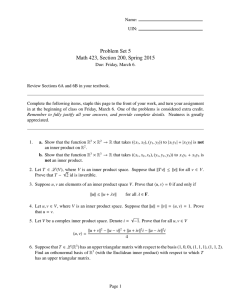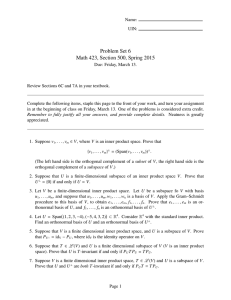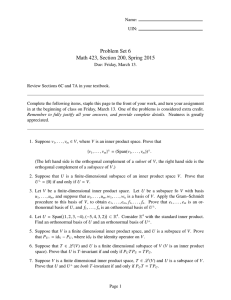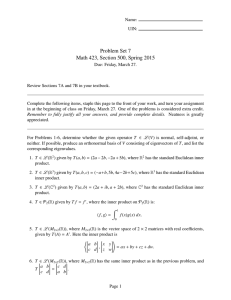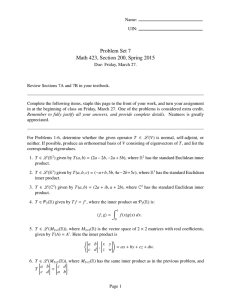Problem Set 5 Math 423, Section 500, Spring 2015
advertisement
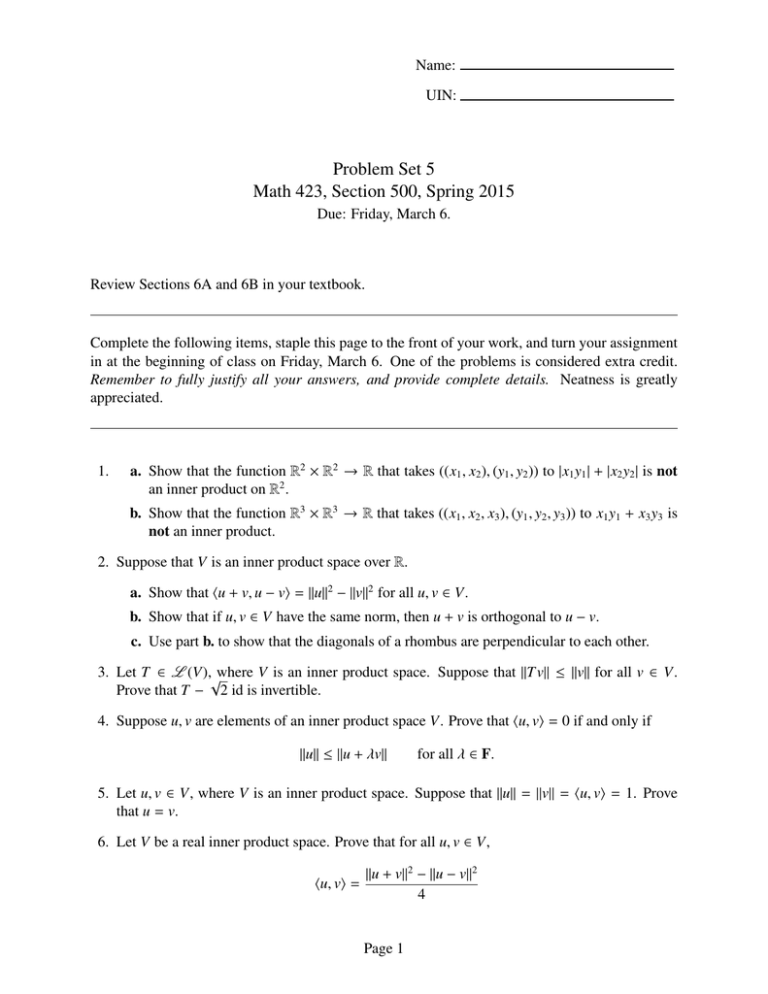
Name: UIN: Problem Set 5 Math 423, Section 500, Spring 2015 Due: Friday, March 6. Review Sections 6A and 6B in your textbook. Complete the following items, staple this page to the front of your work, and turn your assignment in at the beginning of class on Friday, March 6. One of the problems is considered extra credit. Remember to fully justify all your answers, and provide complete details. Neatness is greatly appreciated. 1. a. Show that the function R2 × R2 → R that takes ((x1 , x2 ), (y1 , y2 )) to |x1 y1 | + |x2 y2 | is not an inner product on R2 . b. Show that the function R3 × R3 → R that takes ((x1 , x2 , x3 ), (y1 , y2 , y3 )) to x1 y1 + x3 y3 is not an inner product. 2. Suppose that V is an inner product space over R. a. Show that hu + v, u − vi = kuk2 − kvk2 for all u, v ∈ V. b. Show that if u, v ∈ V have the same norm, then u + v is orthogonal to u − v. c. Use part b. to show that the diagonals of a rhombus are perpendicular to each other. 3. Let T ∈ L (V),√where V is an inner product space. Suppose that kT vk ≤ kvk for all v ∈ V. Prove that T − 2 id is invertible. 4. Suppose u, v are elements of an inner product space V. Prove that hu, vi = 0 if and only if kuk ≤ ku + λvk for all λ ∈ F. 5. Let u, v ∈ V, where V is an inner product space. Suppose that kuk = kvk = hu, vi = 1. Prove that u = v. 6. Let V be a real inner product space. Prove that for all u, v ∈ V, hu, vi = ku + vk2 − ku − vk2 4 Page 1 7. Let V be a complex inner product space. Denote i = hu, vi = √ −1. Prove that for all u, v ∈ V ku + vk2 − ku − vk2 + ku + ivk2 i − ku − ivk2 i 4 8. Suppose that T ∈ L (R3 ) has an upper triangular matrix with respect to the basis (1, 0, 0), (1, 1, 1), (1, 1, 2). Find an orthonormal basis of R3 (with the Euclidean inner product) with respect to which T has an upper triangular matrix. 9. On P2 (R) consider the inner product given by Z 1 hp, qi = p(x)q(x)dx 0 (you do not need to prove that this is an inner product). Apply the Gram-Schmidt procedure to 1, x, x2 to produce an orthonormal basis of P2 (R). 10. Find an orthonormal basis of P2 (R) (same inner product as in the previous exercise) such that the differentiation operator on P2 (R) has an upper triangular basis with respect to this matrix. 11. Find a polynomial q ∈ P2 (R) such that p 1 2 = Z 1 p(x)q(x)dx 0 for all p ∈ P2 (R). 1/10 2/10 3/10 4/10 5/10 6/10 7/10 8/10 9/10 10/10 11/10 Through the course of this assignment, I have followed the Aggie Code of Honor. An Aggie does not lie, cheat or steal or tolerate those who do. Signed: Page 2 Total/100
